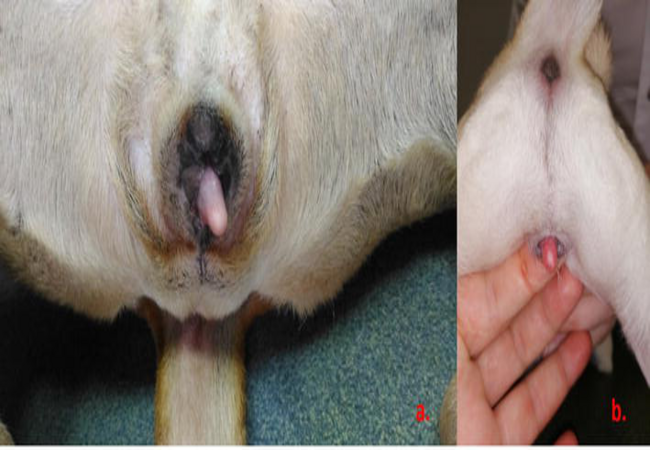Vet’s 2025 Guide to Canine Sexual Development Disorders Understanding & Managing DSD 🩺

In this article
Vet’s 2025 Guide to Canine Sexual Development Disorders: Understanding & Managing DSD 🩺
By Dr. Duncan Houston BVSc
💡 What Are Disorders of Sexual Development (DSD)?
Canine DSDs encompass a range of congenital conditions where the dog’s chromosomal, gonadal, or phenotypic sex is atypical, leading to ambiguous genitalia, infertility, hormonal syndromes, or reproductive tract anomalies.
🌍 Classifications of Canine DSD
-
Chromosomal DSD:
- XXY (Klinefelter’s): phenotypic male, small testes, sterile.
- XO (Turner-like): phenotypic females with ovarian hypoplasia, infertility.
- XXX (Trisomy X): phenotypic females, often infertile, potential behaviour issues.
-
Gonadal DSD:
- True hermaphroditism/ovotestes: both ovarian and testicular tissue present (XX or XY), ambiguous genitalia.
- XX sex reversal: XX without SRY gene but with testes or ovotestes.
- Persistent Müllerian Duct Syndrome (PMDS): XY males retain uterus/fallopian structures, common in Schnauzers.
-
Phenotypic DSD:
- Male pseudohermaphroditism: XY with testis but feminized structures due to androgen insensitivity.
- Female pseudohermaphroditism: XX with ovaries but masculinized genitalia (very rare).
- Hypospadias, cryptorchidism, gonadal hypoplasia/hypoplastic vulva.
🔍 Why It Happens
- Chromosome nondisjunction leads to XXY, XO, or XXX karyotypes.
- Developmental gene mutations (e.g., SRY translocation or PISRT1) lead to sex reversal.
- Hormonal receptor dysfunction (androgen insensitivity or 5α-reductase deficiency) impairs masculinization.
- PMDS is genetic and recessive in breeds like Miniature Schnauzers.
👁 How It Presents Clinically
- Ambiguous or atypical genitalia: enlarged clitoris, redundant prepuce, hypospadias.
- Cryptorchid testes, uterine tissue in males, retained Müllerian structures.
- Delayed or absent puberty, infertility, unusual estrous cycles.
- Overgrowth of clitoris (os clitoris), vaginal strictures, urinary accidents, pyometra.
- Behavioural or urinary issues, particularly in trisomy X or androgen insensitivity.
🧪 Diagnostic Pathway
- Physical exam & history: examine genitalia, symmetry, and descent of testes.
- Ultrasound / imaging: detect internal gonads, uterus, ovarian or testicular tissue.
- Hormonal testing: testosterone, estrogen, LH/FSH after GnRH/hCG stimulation.
- Karyotyping/genetics: detect XXY, XO, XXX, mosaicism/chimerism.
- Histopathology: biopsy of gonadal tissue to confirm ovary, testis, or ovotestis.
- Rule out endocrine disease: e.g. adrenal hyperplasia, androgen-producing tumors.
🛠 Treatment & Care
- Gonadectomy/hysterectomy: remove abnormal glands, neoplastic tissues, and uterus in PMDS.
- Neutering: prevents hormone-driven issues, reduces neoplasia and unwanted reproduction.
- Corrective surgery: hypospadias or clitoral reduction to prevent infections/urinary issues.
- Hormone therapy: rarely indicated except for residual endocrine imbalances.
- Behavioural management: address urinary incontinence, marking, aggression in trisomy X or masculinised individuals.
📈 Prognosis & Breeding Guidance
- Neutered DSD dogs live normally; risk of gonadal tumors is reduced.
- Fertility is rarely possible—avoid breeding affected individuals and siblings.
- Some DSD dogs face higher risks: pyometra in females, Sertoli-cell tumors in testes.
- Regular follow-ups: monitor behavior, urinary health, hormone-related risks.
🚫 Preventing DSD in Breeding
- Avoid breeding dogs with known sex chromosome or gonadal abnormalities.
- Confirm breed lines, advertise karyotype-tested stud/dam—especially in predisposed breeds.
🏡 Ask A Vet At‑Home Monitoring & Support
- 🗓 Reminders: neutering/prep dates, post-surgical checks, veterinary appointments.
- 📸 Photo logs: genital appearance, swelling, urinary leakage, behavior.
- 📊 Track: hormone test dates/results, behavioral patterns, incontinence episodes.
- 🔔 Alerts: signs of infection, pyometra, tumor development.
- 📚 Resources: surgical aftercare, training tips, urinary hygiene.
🔑 Key Takeaways
- DSDs in dogs include chromosomal, gonadal, and phenotypic anomalies.
- Diagnose via physical exam, imaging, hormonal assays, and genetic testing.
- Neutering and removal of abnormal tissue are central to treatment.
- Breeding affected dogs is discouraged; monitoring ensures long-term health.
- Ask A Vet app empowers owners with reminders, monitoring, and expert support.
🩺 Final Thoughts ❤️
In 2025, veterinary care for canine sexual development disorders balances accuracy in diagnosis, thoughtful surgical and hormonal management, and a strong emphasis on quality of life. Neutering, abnormal tissue removal, and corrective procedures help affected pups lead healthy lives. With ongoing monitoring and support via the Ask A Vet app—owners can stay proactive with post-op care, behavioural issues, and urinary health. 🐾✨
Visit AskAVet.com and download the Ask A Vet app to schedule neutering reminders, log appearance changes, track hormone tests, monitor behaviour, and stay connected with your veterinary specialist—all from your phone. 📲






